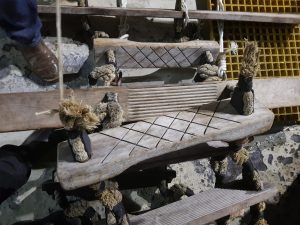The Charity
Aviation
Maritime
Proactive Port Authority

Initial Report
Outline:
A report of a combination ladder deficiency and the follow up which involved both the port authority and the regulatory authority (Port State Control).
What the Reporter told us:
This vessel presented itself for a pilot boarding with the following deficiencies;
- The accommodation ladder was steeper than 45 degrees and was not secured to the ship’s side, while the pilot ladder was not attached to the ship’s side 1.5m above the accommodation ladder platform.
- The accommodation ladder was attached to the pilot ladder, but neither the accommodation ladder nor the pilot ladder were attached to the hull – despite all the necessary sunken fixtures being available.
- Catastrophic rust was noted in way of stanchions and fittings.
- Manropes were rigged incorrectly, had knots or splices in the length of the rope, and were fitted with spliced eyes and shackles on the end of the rope.
There was only a very limited spoken English on board, leading to communications difficulties when trying to rectify the situation.
The manager of the Port Authority wrote to the vessel’s managers detailing the deficiencies and requiring them to examine the arrangement. The vessel was instructed to replace any equipment which did not meet the required standard (in this case the country’s regulatory enactment of SOLAS V23).
The managers were informed that if the vessel presented itself at the port in the future with a deficient pilot transfer arrangement, then the pilot service would be refused. The managers were also advised that the port would not provide pilotage services unless there was unequivocal evidence showing that all corroded pilot transfer arrangement equipment had been remedied. CHIRP note – this is an edited extract of the letter with names of port and country omitted.
Further Dialogue:
CHIRP was impressed with the nature of this intervention and further dialogue revealed the following.
At this port we started an initiative two months ago to educate Industry (charterers, exporters, shipping agents, owners, etc). In short, we advised that from January 01st 2019 we would take a more prescriptive approach, so industry needs to be aware that delays to shipping may result from inadequate pilot transfer arrangements. The two months lead time was in acknowledgement of the fact that charters may have been arranged already – basically, we are trying to get charterers in particular to consider pilot boarding arrangements in their vetting processes (assuming of course that they actually utilise a vetting process). The relevant advice to industry consisted of a letter to thirteen managers / charterers or their agents who have been found to be non-compliant in the recent past.
We now require the ship’s pilot ladder certificate as part of our pre-arrival regime and this simple tool has already raised awareness.
Our approach is at all times to educate and assist as much as we possibly can, and the response from ships has been excellent to date, with vessels doing hot work at times to ensure adequate fixing points or stanchions. Many ships simply need a bit of seamanship advice which we freely offer. We have also purchased equipment (pilot ladder and magnets) which we will supply to ships to avoid delays. Equipment is provided on a ‘you use it, you own it’ basis.
CHIRP Comment:
This is the first time CHIRP has seen a port authority acting in unison with the regulator and proactively trying to educate vessels in order to bring down the number of vessels with deficiencies. Although we are happy to promulgate this message, it is ground that has been covered before. The suggestion that certificates need to be provided as part of the pre-arrival information is a good initiative and is fully encouraged.
CHIRP is aware of the pilots in this particular country being very proactive in highlighting issues and bringing them to the attention of the regulator and the port authority. Whilst it is appreciated that the actual authority comes from the regulator (i.e. Port State Control), this report demonstrates their willingness to proactively interact with ports / pilots, to discourage poor practices and to take action.
Historically the tendency to deal with deficiencies was to use phraseology such as “The next time you visit we will…” This report demonstrates that when a vessel turns up ill equipped, this regulator is prepared to take immediate action. Hitting owners and managers in the pocket by delaying the ship will certainly get their attention and help change behaviours!
Reports being properly actioned so as to prevent a repetition might put an end to situations like the one illustrated below. In this scenario, the pilot actually placed his weight on the ladder and the ropes simply collapsed. Fortunately, this was whilst testing the ladder prior to disembarkation, but had this not been the case then the consequences might have been tragically different.

Deathtrap – pilot placed his weight on this ladder prior to disembarking and both side ropes parted!!
Of note – in the last few months CHIRP has received in excess of 30 pilot ladder and / or combination ladder deficiencies, so the topic is still “hot” and needs addressing. Another Insight article on the subject will be published on the chirpmaritime.org website in the near future.
Report Ends………………







